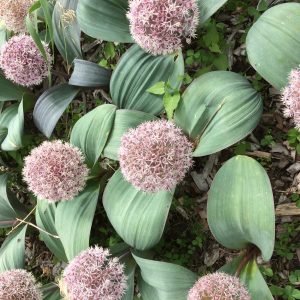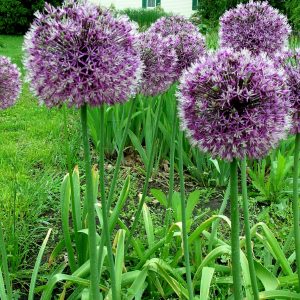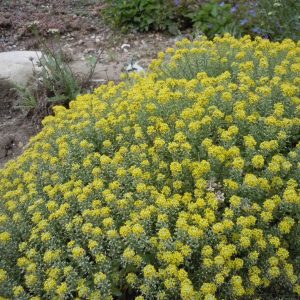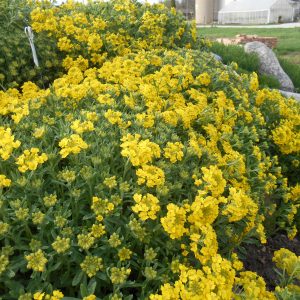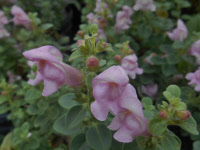Archives
- Sorry, this product cannot be purchased.
Showing 17–24 of 199 results
-
Allium karataviense Turkestan onion, Kara Tau garlic Z 5-9
Basal rosette of wide, glaucous, arching leaves from which a soft-ball sized soft pink to white flower emerges in early summer, ephemeral
ARCHIVED
Note: This is a plant not currently for sale. This is an archive page preserved for informational use.
Basal rosette of wide, glaucous, arching leaves from which a soft-ball sized soft pink to white flower emerges in early summer, ephemeral
We are very sorry, but due to state agricultural restrictions, we are not permitted to ship Allium bulbs to Idaho, or to the following five counties in the State of Washington: Adams, Benton, Franklin, Grant and Klickitat.
Size: 9” x 6”
Care: sun in well-drained soil
Native: central Asia – the Stans (Kyrgyzstan, Tajikistan, Uzbekistan, Afghanistan).
Wildlife Value: value: resistant to rabbits & deer. Attracts bees and butterflies
Awards: Elisabeth Carey Miller Botanic Garden Great Plant Pick, Royal Botanic Garden Award of Garden Merit1st described in 1875 by German botanist Eduard August von Regel (1815-1892) who served as the Director of the Imperial Botanical Garden of St. Petersburg Russia
-
Allium rosenbachianum Z 5-9
Decadent, huge purple balls in June
OUT OF STOCK
Note: This is a plant not currently for sale. This is an archive page preserved for informational use.Decadent, huge purple balls in June
We are very sorry, but due to state agricultural restrictions, we are not permitted to ship Allium bulbs to Idaho, or to the following five counties in the State of Washington: Adams, Benton, Franklin, Grant and Klickitat.
Size: 36”x 6”
Care: full to part sun in moist well-drained to well-drained soil
Native: TurkestanCollected from the wild about 1894.
1st described by German botanist Eduard August von Regel (1815-1892) who served as the Director of the Imperial Botanical Garden of St. Petersburg Russia -
Alyssum oxycarpum Z 4-9
Rare plant with bright yellow racemes in May to August over compact mound of bright silver foliage.
ARCHIVED
Note: This is a plant not currently for sale. This is an archive page preserved for informational use.
Rare plant with bright yellow racemes in May to August over compact mound of bright silver foliage.
Size: 6” x 8”
Care: sun in moist well-drained soil
Native: TurkeyDescribed in botanical literature in 1856. One of my favorites for rock gardens or any sunny spot, due to its long bloom, yellow mounded blooms & compact silver foliage.
-
Alyssum wulfenianum syn. Alyssum ovirense Alpine alyssum, Madwort Z 3-9
Spring to early summer, clumps of sunny yellow blooms over gray foliage
ARCHIVED
Note: This is a plant not currently for sale. This is an archive page preserved for informational use.
Spring to early summer, clumps of sunny yellow blooms over gray foliage
Size: 4-6” x 12-18”
Care: sun in well-drained soil
Native: GermanyDescribed in Willdenow’s Enum. pl. suppl. Before 1814. Grown at the Agricultural Center in Beltsville Maryland in 1897.
-
Antennaria dioica Pussy toes Z 5-9
Pale pink “pussy-toe”, resembling the pads of a kitten’s foot
ARCHIVED
Note: This is a plant not currently for sale. This is an archive page preserved for informational use.
Pale pink “pussy-toe”, resembling the pads of a kitten’s foot, flowers in early summer, great silvery-gray foliage, good groundcover and rock garden plant.
Size: 2” x 18”
Care: full sun in well-drained soil, drought tolerant
Native: Temperate areas worldwideAntennaria from the Latin antenna originally referring to the mast of a sailboat. Part of the flower supposedly resembles a butterfly’s antennae. Historically used for medicine as an astringent, a cough remedy and to break fever. First described by German physician and botanical author Leonhard Fuchs (1501-1566). Gertrude Jekyll (1848-1931), mother of the mixed perennial border, planted this in her own rock garden at Munstead Wood and in the Sundial Garden at Pednor House in Buckinghamshire. The pink version, A. dioica rosea, collected in the Rocky Mountains by C.C. Parry before 1860.
-
Anthyllis vulneraria v. coccinea Red Kidney vetch, Woundwart Z 5-9
Foliage - low mound of downy silvery-green leaves, topped by ball-shaped red flowers May to July – showy, long-blooming makes wonderful groundcover or rock garden plant
ARCHIVED
Note: This is a plant not currently for sale. This is an archive page preserved for informational use.
Foliage – low mound of downy silvery-green leaves, topped by ball-shaped red flowers May to July – showy, long-blooming
Size: 4-6” x 12-18”
Care: sun in well-drained soil
Native: Europe
Wildlife Value: sole food plant for small blue butterfly caterpillars. Flowers provide nectar and pollen for beetles and bees.
Size: Showy, long-blooming makes wonderful groundcover or rock garden plantIn traditional medicine used externally to promote wound healing and internally as a laxative and for kidney disorders. Species is ancient written about by Greek Dioscordes. Red variety since at least 1753.
-
Antirrhinum hispanicum ‘Roseum’ syn. A. glutinosum Perennial snapdragon, Spanish snapdragon Z 5-8
Rose pink, with yellow above the lower lip, snapdragon-shaped blooms in spring, repeats in fall. Fuzzy, silver-grey foliage
ARCHIVED
Note: This is a plant not currently for sale. This is an archive page preserved for informational use.
Rose pink, with yellow above the lower lip, snapdragon-shaped blooms in spring and repeats in fall. Fuzzy, glaucous, silver-grey foliage. Excellent for places you want low-growing, drought tolerant flowers.
Size: 12” x 2’
Care: sun in well-drained soil
Native: Spain & Morocco
Wildlife Value: deer resistant, attracts hummingbirdsDescribed in 1852 in Pugillus Plantarum Novarum Africae Borealis Hispaniaeque Australis
-
Arabis caucasica syn. A. alpina subsp. caucasica Alpine Rock Cress (Bastard Tower Mustard, Miller 1768) Z 4-9
Late spring white four-petaled racemes. Perfect for a dry border or rock garden. Drought tolerant.
ARCHIVED
Note: This is a plant not currently for sale. This is an archive page preserved for informational use.
Late spring white four-petaled racemes. Perfect for a dry border or rock garden. Drought tolerant.
Size: 6-12”x 20” spreads
Care: Full sun well-drained soil, vigorous; cut back after flowering to make it full.
Native: Southern Europe and Mediterranean.
Size: Perfect for a dry border or rock garden. Drought tolerant.Arabis is Greek for Arabian. Cultivated in the U.S. since 1800’s.

